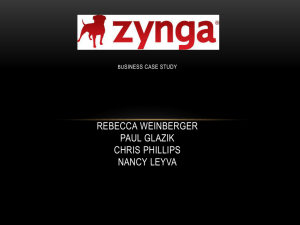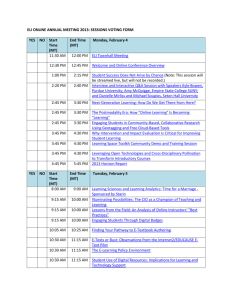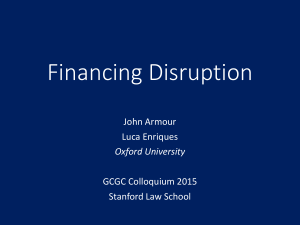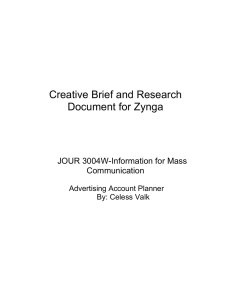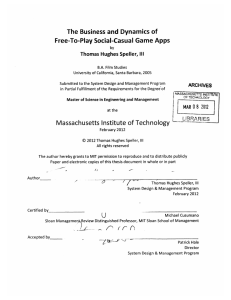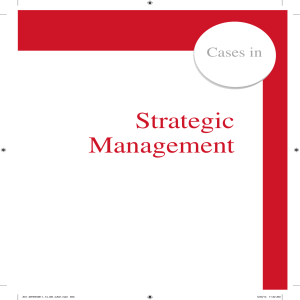this document - the Enhancement Themes website
advertisement
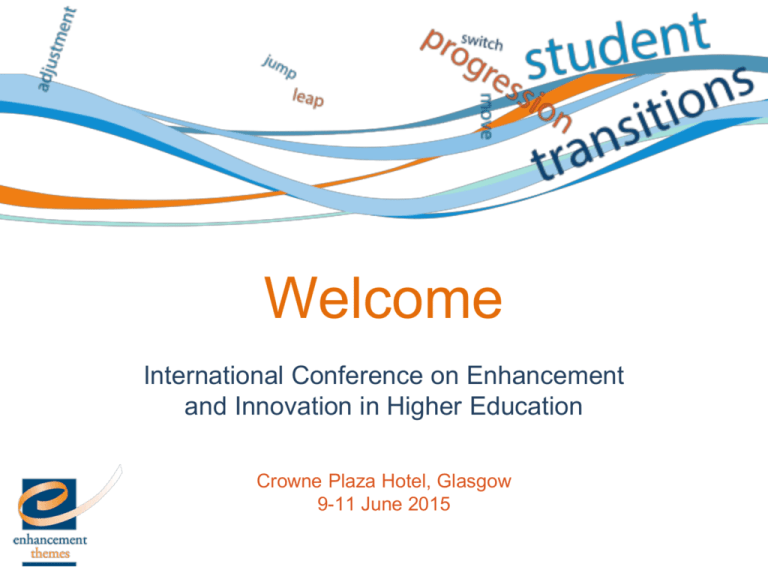
Welcome International Conference on Enhancement and Innovation in Higher Education Crowne Plaza Hotel, Glasgow 9-11 June 2015 Jason Robertson University of the West of Scotland Digital Pigs and Digital Natives: How FarmVille Prefigures The Future of Higher Education Purpose of HE The 1997 report of the National Committee of Inquiry into Higher Education argued higher education should sustain a learning society with four main purposes: · to inspire and enable individuals to develop their capabilities to the highest potential levels throughout life, so that they grow intellectually, are well equipped for work, can contribute effectively to society and achieve personal fulfilment · to increase knowledge and understanding for their own sake and to foster their application to the benefit of the economy and society · to serve the needs of an adaptable, sustainable, knowledgebased economy at local, regional and national levels · to play a major role in shaping a democratic, civilised, inclusive society. Purpose of HE • Freire’s “banking” model. • Chomsky’s “enlightenment” model. • Neoliberalism’s “surplus of income over expenditure” (profit) model. For the student • Reputation • Qualification • Experience • Employment Thinning of the herd • Standard & Poor: “It is our belief that colleges or universities that are unable to distinguish themselves in the market through their reputation or offerings will have to compete for students purely on price, which will weaken demand and possibly cut into their enrolments over time”. • “middle-tier” universities without sufficient resources to reinvest may go out of business or have to merge with others. Economist (June 28th 2014): Students at universities just below Ivy League level are more sensitive to the rising cost of degrees, because the return on investment is smaller. Those colleges might profit from expanding the ratio of online learning to classroom teaching, lowering their costs while still offering the prize of a college education conducted partly on campus. The Problem With MOOCs • Plutonomy & precariat • Costs • Dominated • Compete • Free by established brands or join aggregator must have value • Certificaion - and must have value • Monetisation • Soft skills • Measurement of medium and long-term impact MOOCs Kalman (2014): MOOCs “are beneficial mainly to a minority of highly self-motivated individuals who already have a solid academic background” and poorly serve those from disadvantaged backgrounds and also form developing countries. Mazoue (2013): “skews toward autodidacts and more advanced learners. Novice learners needing instructional guidance are largely on their own and no better off perhaps than those in a large gateway course delivered in a lecture hall on campus. Although improving the quality of student learning is one of the priorities of the major MOOC providers, most of their courses currently lack a sophisticated learning architecture that effectively adapts to the individual needs of each learner.” Udacity employs state-of-the-art technology and sophisticated pedagogical strategies to keep their users engaged, peppering students with quizzes and gamifying their education with progress meters and badges. But a recent study found that only 7% of students in this type of class actually make it to the end. Technology & Education Umair Haque: • “sets of practices so familiar that they become institutionalised, frozen in place” • “disrupt yourself before someone comes along and does it” (Google). “The same technology that enables files to be shared easily also offers an unprecedented opportunity to build oneto-one relationships with your customers and fans. The web enables artists and businesses to share what they do at a very low cost while building relationships with customers…. How you choose to respond to this opportunity will determine how you fare in the digital age.” Nicholas Lovell. What business are we in? • A move from scarcity and monopoly to abundance and low margin costs. • The creative disruption of digital technology. • (Schumpeter’s “creative disruption” & Clay Christensen’s “innovator’s dilemma” - oligarchs concentrate on existing customers and established ways to maintain dominance. Innovators look for new ways and new customers). Economist (2012): “Anant Agarwal, who runs edX, proposes an alternative to the standard American four-year degree course. Students could spend an introductory year learning via a MOOC, followed by two years attending university and a final year starting part-time work while finishing their studies online…..Some universities are already adding digital classes to their syllabuses. In Brazil, Unopar University offers low-cost degree courses using online materials and weekly seminars, transmitted via satellite. In America, Minerva University has entry criteria to rival the best Ivy League colleges, but far lower fees (around $10,000 a year, instead of up to $60,000). The first batch of 20 students has just been accepted for Minerva’s foundation year in San Francisco, and will spend the rest of their course doing online tutorials while living outside America, with an emphasis on spending time in emerging economies as a selling-point to future employers.” • Open University • Plus most universities commercial online products. • FutureLearn • Cogbooks (for business) • edX • Udemy • Udacity • Minerva • Fullbridge • Harvard/MIT • Khan • MIT Academy OpenCourseWare • Coursera. • ALISON • Unopar Economist (2014 June 28th): “a more varied MOOC-ecology might end up with varying price-tiers, ranging from a basic free model to more expensive bespoke ones.” Kirschner’s three parallel online models: One is free access to the course materials, including progress assessments. No supporting services are provided. A second is to provide tutorial support for the course materials at a fee that supports access to faculty—similar to “auditing” in U.S. universities. The third is the complete course, including certification assessment and certification for academic credit.” Traditional Games Income One-off payment (box-sales, nine payment). Subscription Virtual currency Sponsorship/donations/crowdsource Perfect price discrimination. Scarcity and luxury Rentals (serial purchases, appears less objectionable than paying again for upgrade) Advertising/adware Seasons Server-leasing - hire space to others Flow • Immersion: Simulation games make the most money, followed by adventure, then role-play. • Key Free-To-Play (F2P) games producers/publishers are: Zynga, Team Lava, EA, Gameloft, Glu, Admired, Pocket Gems, Storm8, Rovio, Popcap, TinyCo, Z2Live and Disney. • F2P games include Plants V Zombies (also P2P upgrades), Clash of Clans, and FarmVille (the latter 3 with in-game purchase options: upgrades, special items, updates, catch-ups, expansion packs, level unlocks etc. via micro-payments). All also offer merchandise. Perceived value • Gifts (shared) (some exclusive) • Achievements • Expansion • Viral In-game purchases Activity metrics Iteration cycles Compulsion loops Asynchronous parallel development and interaction Platforms datamine, then optimise and personalise content for the player. Marc Andreessen: “A lot of people looked at Facebook and saw a Web site. None of the people close to Mark and the company thought of Facebook as a Web site. They think of it as a data set, a feedback loop.” Ken Rudin famously declared, "We’re an analytics company masquerading as a games company." The whole games industry now uses player analysis and iteration to alter games postrelease. And now Rubin is head of analytics at Facebook, which is effectively an analytics company masquerading as a social network.” FREE need not be a threat. (It can be our competitive advantage!) An opportunity to talk to more customers than ever before at a very low cost. Value our freeloaders. They evangelise and sometimes convert. Use free to find an audience (content marketing - build a relationship via the quality of experience and use analytics and data tools to understand the audience. Make your customers want you to contact them again or come back on their own). Create a customer relationship management system. Use technology to stay in touch with that audience and figure out what they value. Allow those who love what you do to spend lots of money on things they really value. The Zynga Philosophy Since its inception in 2007, Zynga has generated more than $1.5 billion in revenues. The Zynga Philosophy Since its inception in 2007, Zynga has generated more than $1.5 billion in revenues. But the core element of their product is FREE. A FREEMIUM model. The Zynga Philosophy Free = Content Marketing. Zynga • Only about 2.5% of users pay for something. • But their audience is global. Zynga Big bankroll! Zynga Dashboard for analytics. Which metrics matter - track them. Train staff in use. OKRs. (Objectives and key results) - constant quality and efficacy review and updates. Permanent beta-testing. Fail fast and adapt. A stable platform. Design for an expanded market and new users. Technology allows consumers to choose based on filtering and community recommendations. Shareware - try before you buy. Free pathway. Disaggregate and scaffold - increasing challenge. Micro-transactions - disaggregated. FTUE. (First-Time User Experience). Engagement, discovery, achievement and reward. What you want where you want how you want it. Immediate reward to bind the user. Guided tutorial and refined interface. Allow players to progress by helping their friends. Use of call-to-action, reminders to rejoin and updates on progress of others (and enable to help stragglers) plus crowd-source support; peerpressure; gawking and grandstanding. Biggest spenders don’t start spending until they have played the game at least eight times. The best opportunity to make an impression is in the first three clicks. Perpetual users (life-long learners) - the gift that keeps on giving. Strategic partnerships - platforms. Cross promote. User generated content (on platform and on social media). Customisation/autonomy. Get lots of users, improve conversion rate, and let them spend as much as they want. Spend money to acquire users . Interact in deep ways. Improve the quality of the social experience. Social and viral hooks (reward shares and likes, post scores, rating and feedback). Word of mouth - Farmville added 300,00 users a day/14 million registered in a matter of months). Viral loop - UGC, posts to social networks. Social: gawking, being seen and cooperation. Fun! Zynga By autumn of 2009, Zynga was selling something like 800,000 virtual tractors a day. (All of that was happening amid the greatest financial collapse in modern times). February, 2010, Zynga had six of the top 10 games on Facebook and had more than 239 million monthly active users. FarmVille alone had more than 79 million users. The wider the funnel, the more potential converts. Free Freemium Free Then Pay Multi-level/multi-price points • • • Level 1: FREE OER Augmentation Multi-level/multi-price points • • Level 2: Online Paying Customers Multi-level/multi-price points • • Level 3: UPSELL! Full-service Paying Customers Value is complex and variable. Flat pricing is an anachronism. If they want to spend more, enable them! “inapp” purchases and upgrades make money. It’s a social experience, and content aggregators are important doorways to the public. Analytics, tracking and iterative redevelopment and customisation for consumer. Customer management system. The User Communities The resource can operate at all levels: a) a public resource/new students to join undergraduate b) on-line-only students c) existing students on traditional campus d) graduates/professionals - upgrade, update, new specialism e) pop-up campus
